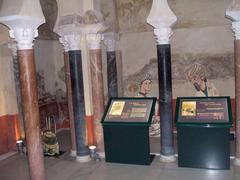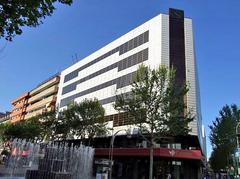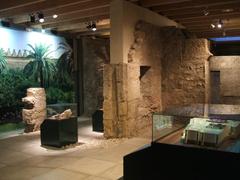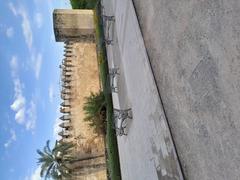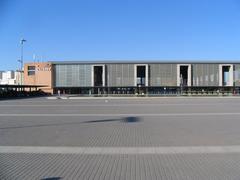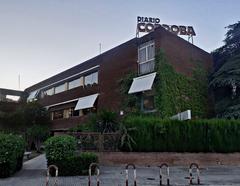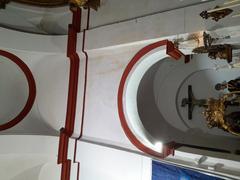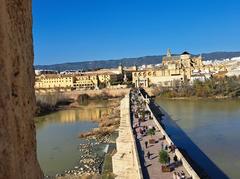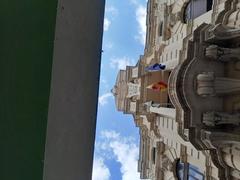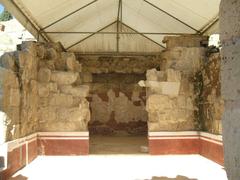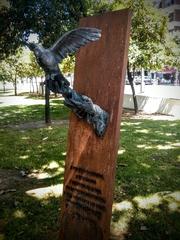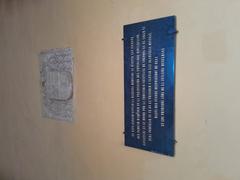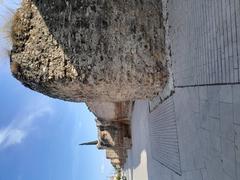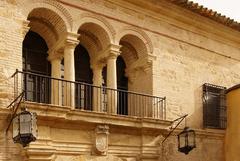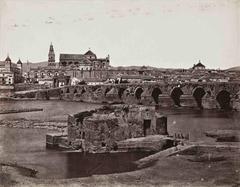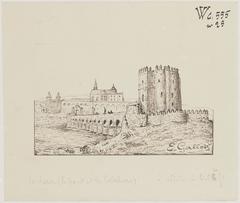
Puerta del Puente Visiting Guide: Córdoba, Spain – Tickets, Hours, and Tips
Date: 04/07/2025
Introduction to Puerta del Puente in Córdoba
Situated at the southern edge of Córdoba’s UNESCO-listed historic center, the Puerta del Puente (Gate of the Bridge) stands as a testament to the city’s layered Roman, Islamic, and Renaissance heritage. Once a strategic access point across the Guadalquivir River, this Renaissance monument now welcomes visitors as a symbol of Córdoba’s enduring legacy. Whether you are a history buff, architecture enthusiast, or a curious traveler, Puerta del Puente offers a fascinating journey through centuries of urban evolution, making it an essential stop on any Córdoba itinerary (Evendo, The Gap Decaders, queverencordoba.org).
Table of Contents
- Historical Overview
- Architectural Features and Symbolism
- Role in City Life and Urban Development
- Visiting Information
- Visitor Experience and Tips
- Nearby Attractions
- FAQs
- Practical Resources & Further Reading
- Summary
Historical Overview
Roman and Islamic Origins
The location of Puerta del Puente has served as a principal entrance to Córdoba since Roman times, anchoring the northern end of the ancient Puente Romano (Roman bridge), which dates back to the 1st century BCE. Archaeological evidence suggests a three-arched Roman gateway once controlled access to the city, acting as a bustling hub for trade, military, and civic life (Sommertage, itinerartis.com).
During the Islamic period, the gate was fortified to defend the approach to the Great Mosque (Mezquita-Catedral) and the Alcázar. The Umayyad Caliphate reinforced the city’s defenses, and the gate became a crucial checkpoint for travelers, merchants, and dignitaries arriving from across Al-Andalus and North Africa (itinerartis.com).
Renaissance Reconstruction
By the 16th century, Córdoba’s medieval fortifications were in decline. In 1572, King Philip II commissioned a new monumental gate to modernize the city’s image and celebrate his royal visit. The renowned architect Hernán Ruiz III designed the Puerta del Puente in the Renaissance style, drawing inspiration from classical Roman triumphal arches. The project integrated Doric columns, a central arch, and harmonious proportions in local limestone, imparting the structure with both defensive and ceremonial grandeur (Evendo, turismodecordoba.org).
Subsequent restorations, particularly in the 20th and 21st centuries, have preserved the gate’s freestanding form and improved its visibility and accessibility, ensuring its enduring role in Córdoba’s urban landscape.
Architectural Features and Symbolism
The Puerta del Puente exemplifies Spanish Renaissance architecture with its tripartite layout: a large central semicircular arch flanked by two smaller rectangular openings. Fluted Doric columns support a classical entablature, while sculptural reliefs and inscriptions commemorate King Philip II’s visit and the city’s historical milestones. Medallions and heraldic symbols evoke royal authority and civic pride.
Local limestone and traditional stone-cutting techniques highlight Renaissance craftsmanship, while the gate’s thick walls recall its defensive origins. The latest restorations have enhanced nighttime illumination, making it a photogenic landmark after dark (turismodecordoba.org).
Role in City Life and Urban Development
Historically known as the Algeciras Gate, the Puerta del Puente was Córdoba’s main southern entrance, regulating trade and movement while marking the start of the ancient Via Augusta. In modern times, it serves as a vibrant gathering space for locals and visitors, especially during festivals and processions. Its location at the intersection of the city’s most iconic monuments cements its role as a symbolic and practical hub in Córdoba’s historic center (Evendo, The Gap Decaders).
Visiting Information
Hours and Tickets
- Exterior Viewing: Accessible 24/7; the monument is located in a public plaza.
- Interior Exhibition & Rooftop Mirador: Typically open daily from 10:00 to 14:00. Hours may vary on public holidays or due to maintenance—verify current schedules before your visit (queverencordoba.org).
- Tickets: €1 for visitors aged 5 and up; free for children under 4. Tickets are available at the adjacent Visitor Reception Center (queverencordoba.org).
Getting There
- On Foot: Just a 2-minute walk from the Mezquita-Catedral.
- Public Transport: City buses stop at “Puerta del Puente” and “Mezquita-Catedral.”
- By Car: Parking is limited in the historic center; use public lots nearby and enjoy a scenic walk (theglobetrottingteacher.com).
- From Stations: A 20-minute walk or short taxi ride from the train and bus stations.
Accessibility
- Ground Level: Wheelchair and stroller accessible with ramps and flat pathways.
- Rooftop Mirador: Accessible by stairs only.
Guided Tours
While self-guided visits are popular, many local tour operators include Puerta del Puente on walking tours of Córdoba’s historic center, often bundled with the Mezquita-Catedral, Roman Bridge, and other landmarks for a richer historical context (Evendo, queverencordoba.org).
Visitor Experience and Tips
- Best Time to Visit: Early mornings for quiet exploration; late afternoons for sunset photos. Evening visits are popular due to the monument’s illumination (soi55lifestyle.com).
- Photography: Capture the Roman Bridge framed by the gate’s arch for iconic shots. Please avoid climbing or sitting on the structure.
- Weather: Summers are hot—bring water and sun protection, and plan for shade or indoor visits midday.
- Practicalities: Restrooms and tourist information are available at the Visitor Reception Center. Cards are widely accepted, but have some cash for small fees.
Nearby Attractions
- Mezquita-Catedral: Córdoba’s world-renowned Mosque-Cathedral, just steps away.
- Roman Bridge: A scenic stroll with views of the city.
- Alcázar de los Reyes Cristianos: Fortress and gardens a short walk away.
- Torre de la Calahorra: Across the Roman Bridge, offering river and city views.
- Jewish Quarter and Plaza del Triunfo: Historic districts nearby.
Combine your visit for a comprehensive experience of Córdoba’s architectural and cultural highlights (thecrazytourist.com, touropia.com).
FAQs
Q: What are the Puerta del Puente visiting hours?
A: The exterior is always accessible; the interior and rooftop are generally open 10:00–14:00. Hours may change on holidays—check ahead (queverencordoba.org).
Q: What is the ticket price?
A: €1 for ages 5+; free for under 4s.
Q: Is the site wheelchair accessible?
A: Ground level is accessible; the rooftop mirador requires stairs.
Q: Are guided tours available?
A: Yes, via local operators and official tourism offices.
Q: Can I take photographs?
A: Yes, non-flash photography is allowed inside and outside. Drones require special permission.
Q: Is the area safe?
A: Yes, it is well-patrolled and safe, including at night (soi55lifestyle.com).
Practical Resources & Further Reading
- Puerta del Puente (Evendo)
- Qué Ver en Córdoba: Puerta del Puente Guide
- Turismo de Córdoba – The Gate of the Bridge
- The Gap Decaders – Visit Córdoba
- Sommertage – Córdoba Travel Tips
- Itinerartis: The Roman Córdoba Route
- Touropia: Tourist Attractions in Córdoba
- Soi55Lifestyle: Córdoba Travel Guide
- The Crazy Tourist: Best Things to Do in Córdoba
- The Globetrotting Teacher: Things to Do in Córdoba
Summary
The Puerta del Puente is more than an architectural marvel; it is a living chronicle of Córdoba’s transformation through Roman, Islamic, and Christian eras. Its strategic location, rich historical context, and distinctive Renaissance design make it a highlight of any visit to the city. Free public access, informative exhibitions, and panoramic viewpoints ensure a rewarding experience for all visitors. Combine your visit with nearby landmarks and consider a guided tour for deeper insights. For enhanced planning and navigation, download the Audiala app, and explore Córdoba’s past and present through this remarkable gateway (Evendo, queverencordoba.org, turismodecordoba.org).

